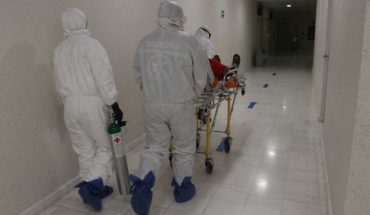Last weekend was two months after the murder of Aideé Mendoza, the student of the College of Sciences and Humanities (CCH) Oriente who died after being shot inside her own classroom. The case remains unclear. So far, three official versions of what may have happened are added up, with no arrests yet being made.
The young woman’s family told Political Animal that after various experiences, the Attorney General’s Office of Mexico City confirmed to them that the shooting came from somepoint in the school and that the origin of everything had been a quarrel over an alleged drug sale. The two previous versions spoke of a shot inside the room or a stray bullet outside the campus.
Read: UNAM students march to demand greater security and justice for Aideé
“Now we are told that this is the strongest version. That it was a shot about 50 meters. And they tell us that they’ve already identified the suspect, that he’s a vandal who was selling drugs and that he had a fight. But so far they haven’t located him and he’s not in custody. The advances they have given us are not enough and it’s been two months,” said Lourdes Cuautle, the young woman’s aunt.
In addition, the issue of alleged negligence in the care of the young woman is pending, for the time it took her to move to a hospital located a few steps from the campus. Cuautle, who is a doctor, has insisted that it is an issue that has to be investigated by the Office of justice, but of which there has been no further progress.
Aideé’s family also asked the National Autonomous University of Mexico (UNAM) to assume responsibility in the case since if the Procurator’s hypothesis is correct, it means that within the CCH there was a young man armed with a heavy-caliber pistol.
Read: Aideé Case: The Contradictions and Doubts About the Murder of the CCH Oriente Student
“At the University we were told that they did their own research and that it was very unlikely that someone was armed inside the school, but we saw how the expertise has shown otherwise. So they either did not investigate (at UNAM) or their investigation is false. They have to respond as well and take action if reviews will be done or something so that something like this can’t happen,” she said.
Last week the Attorney General’s Office convened a press conference in which the first findings of the investigation would be publicly released, but at the last minute the event was cancelled. Dependency authorities indicated the cause of this was that the results of a final request were not yet received.
In that context, Aideé’s aunt said that all they ask for is for “justice to be done and to know what really happened to the girl” who, she insists, was murdered inside her own classroom in full view of virtually everyone. “The investigation has already took too long, ” he insisted.
You may be interested: Aideé, the young explorer who dreamed of studying forensic science at CU
One crime, three versions
The 18-year-old student Aideé Mendoza’s murder occurred on the afternoon of April 29 in a CCH Oriente classroom located in the town hall of Iztapalapa in Mexico City. The young woman was shot in from the side of her body and led to internal bleeding, causing her death.
In the two months since the murder, the authorities responsible for the investigation have handled up to three different versions of how the events occurred.
The first, unveiled by solicitor Ernestina Godoy in post-murder interviews, is that it was a low-caliber bullet that could have been detonated at a short distance. The absence of a percussive cartridge made a device called a bullet pen think of a murder weapon.
Read: Murdered Students, Abuses and Assaults: The Violence Faced by CCH Oriente Students
But a few days later, the results of the first experts carried out by the authorities that revealed that the homicidal bullet was 9-millimeter caliber, and that it was a stray bullet from a long distance, were leaked. Distances were handled from 150 to 400 meters, and even that could have been a shot from a military camp next to the College. That was the second version.
And the third version, also filtered by the authorities, is the one that was unveiled last week where it was established that it would in fact be a stray bullet, but that it came from a much shorter distance: from 40 to 50 meters , so the shot would have come from another point on the campus.
Aideé’s family confirmed that this last hypothesis is in fact the last one communicated to them by the authorities and on it is the one that continues to work.
“Unfortunately the place of the murder was contaminated, very polluted from the beginning. Neither the authorities nor the University itself were interested in protecting it in the best possible way, so you can no longer get it out. It has to be because of the expertise they’ve been doing,” Lourdes Cuautle said.
The preliminary explanation the authorities gave to the relatives is that a young person who has already been identified (not specified if he is a CCH student) and who would be involved in drug-stopping activities, apparently detommed the weapon when he was caught in a quarrel with other people. The bullet would have accidentally hit the young woman inside the classroom.
The family was informed that they have identified that person from data and testimonies collected and are expected to be comsuming their detention these days.
Of which there is no progress, Aideé’s aunt pointed out, it is of the alleged negligence with which the young woman was acted in the attention after she was injured.
Political Animal on 21 May published that the young woman’s transfer to a hospital took at least an hour from the time the assault was committed, and that when she arrived at the health centre – located less than ten minutes from the school – the young woman was already dead.
“We are convinced that there was a lot of medical negligence because the homicide was after 2:00 pm and she arrives at the hospital until 4:00 pm. But the Attorney General’s Office hasn’t told us anything about this yet. I think it’s been a long time and some things would have to be clearer by this point,” he said.
Questioned whether they have adequate legal advice, Aideé’s aunt noted that organizations and lawyers specializing in human rights and even united nations have offered to provide assistance to them, but by decision of the young woman’s mother the case is taken by a lawyer from the church to which she belonged.
A violent year in the capital
The murder of Aideé Mendoza, along with that of other young people and students such as Leonardo Avendaño and Norberto Ronquillo, are some of the most impactful that have been recorded in the capital of the country, which is going through the most violent year in the last decade.
From January to May 2019 a total of 769 people have lost their lives in cases of homicide and femicide in Mexico City, more than 70% of these crimes were committed with a firearm, according to official data of the Executive Secretariat of the National Security System (SESNSP).
Compared to the same period of 2018, 570 homicide victims were then recorded, this is a 35% increase in the number of victims of this crime from one year to the next.
In the current six-year state Mexico City is the third entity with the largest growth of homicidal violence nationwide, behind only Nuevo León and Tabasco. Its average daily homicides already exceed even that of the state of Mexico, an adjoining entity with the highest population density.
What we do in Animal Político requires professional journalists, teamwork, dialogue with readers and something very important: independence. You can help us keep going. Be part of the team.
Subscribe to Animal Politician, receive benefits and support free journalism.#YoSoyAnimal
translated from Spanish: in two months there are three versions and no detainees
July 3, 2019 |





